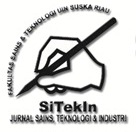Design of Time Out Devices for Amateur Volleyball Games Using ESP32 Microcontroller
Abstract
Full Text:
PDFReferences
S. Lorenzetti, “Innovative technologies in sports games: A comprehensive investigation of theory and practice,” 2024 .
L. Torres-Ronda, E. Beanland, S. Whitehead, A. Sweeting, and J. Clubb, “Tracking systems in team sports: a narrative review of applications of the data and sport specific analysis,” Sports Medicine-Open, vol. 8, no. 1, p. 15, 2022 .
Y. Qi, S. M. Sajadi, S. Baghaei, R. Rezaei, and W. Li, “Digital technologies in sports: Opportunities, challenges, and strategies for safeguarding athlete wellbeing and competitive integrity in the digital era,” Technology in Society, p. 102496, 2024 .
P. Sotiriadou, “Digital Innovation in high-performance sport,” in The Routledge handbook of digital sport management, Routledge, 2022, pp. 91–99.
C. López-Serrano and J. J. M. Martín, “Time-out impact on performance and scoring dynamics in boys’ youth volleyball,” Retos, vol. 65, pp. 1086–1097, 2025 .
M. H. Zimmerman, L. M. Burch, and B. Moritz, Introduction to Sports Journalism. Human Kinetics, 2024.
R. M. Nyman, “The non-verbal behavior of elite football players during knock-out games that went to extra time: Investigating the NVB of players in 2022 World Cup for men during knock-out games.” 2024.
D. K. Ntege, “Impact of the Use of Technology Based Referee System in Football: A Case of Spanish La Liga Video Assistant Referee.” Seoul National University Institutional Repository, 2020.
I. Cunningham, L. Roche, and D. Mascarenhas, “Using mobile 360 video as a tool for enhancing sport referee performance: A case study,” Case Studies in Sport and Exercise Psychology, vol. 7, no. 1, pp. 43–54, 2023 .
A. Braverman, “Improving Team Members’ Attention During the OR Briefing or Time Out,” AORN journal, vol. 119, no. 6, pp. 421–427, 2024 .
E. Hsiang, Z. Yang, Q. Yang, Y. Lan, and S. Wu, “Prospects and challenges of mini‐LED, OLED, and micro‐LED displays,” Journal of the Society for Information Display, vol. 29, no. 6, pp. 446–465, 2021 .
N. Goldschmied, M. Raphaeli, and E. Morgulev, “‘Icing the shooter’ in basketball: The unintended consequences of time-out management when the game is on the line,” Psychology of Sport and Exercise, vol. 68, p. 102440, 2023 .
J. Wittkugel, D. Memmert, and F. Wunderlich, “Substitutions in football–what coaches think and what coaches do,” Journal of Sports Sciences, vol. 40, no. 15, pp. 1668–1677, 2022 .
R. Y. Kanneboina, G. A. E. S. Kumar, R. P. Vidyadhar, V. K. Reddy, and S. Tammineni, “Development of Autonomous Vehicle System using ESP32 Microcontroller,” in 2024 Asia Pacific Conference on Innovation in Technology (APCIT), IEEE, 2024, pp. 1–6.
H. A. Kusuma and T. Suhendra, “Field Testing and QoS Analysis of ESP-NOW Communication on ESP32,” in 2024 FORTEI-International Conference on Electrical Engineering (FORTEI-ICEE), IEEE, 2024, pp. 82–88.
D. Eridani, A. F. Rochim, and F. N. Cesara, “Comparative performance study of ESP-NOW, Wi-Fi, bluetooth protocols based on range, transmission speed, latency, energy usage and barrier resistance,” in 2021 international seminar on application for technology of information and communication (iSemantic), IEEE, 2021, pp. 322–328.
M. Aznabaev, D. Donskoy, and V. Khristoforova, “Research on Wireless Protocols for Organizing a Remote Control and Monitoring System Based on ESP8266,” in 2024 International Russian Automation Conference (RusAutoCon), IEEE, 2024, pp. 456–461.
M. Abotaleb, “Improved performance of Wi-Fi based communication with multiple sensors through collaboration between the WebSerial remote serial monitor and ESP-NOW protocol,” Scientific Journal of Gdynia Maritime University, 2023 .
DOI: http://dx.doi.org/10.24014/sitekin.v22i2.36169
Refbacks
- There are currently no refbacks.
Copyright (c) 2025 SITEKIN: Jurnal Sains, Teknologi dan Industri
 | Editorial Address: FAKULTAS SAINS DAN TEKNOLOGI UIN SULTAN SYARIF KASIM RIAU Kampus Raja Ali Haji Gedung Fakultas Sains & Teknologi UIN Suska Riau Jl.H.R.Soebrantas No.155 KM 18 Simpang Baru Panam, Pekanbaru 28293 © 2023 SITEKIN, ISSN 2407-0939 |
SITEKIN Journal Indexing:
Google Scholar | Garuda | Moraref | IndexCopernicus | SINTA

SITEKIN by http://ejournal.uin-suska.ac.id/index.php

.png)





